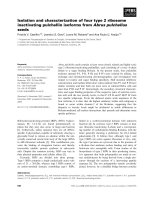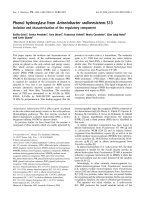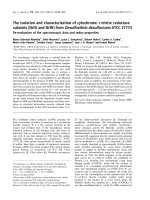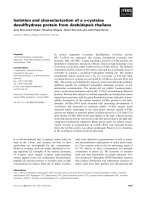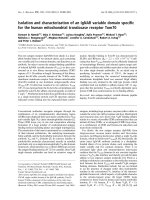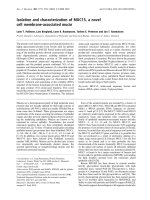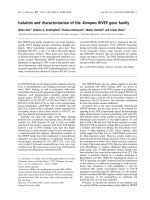Isolation and characterization of an extracellular polymer closely related to flocculation of activated sludge
Bạn đang xem bản rút gọn của tài liệu. Xem và tải ngay bản đầy đủ của tài liệu tại đây (871.51 KB, 12 trang )
Journal of Water and Environment Technology, Vol.3, No.2, 2005
Isolation and characterization of an extracellular polymer closely related to
flocculation of activated sludge
Junichi Tsuge1 and Masuo Nakano2
1
Sapporo Otani Junior College
N16, E9, Higashi-ku, Sapporo, 065-8567
E-mail:
2
Faculty of Dairy Science, Rakuno Gakuen University
582 Bunkyodai Midori-machi, Ebetsu, 069-8501
Abstract
The present study was conducted to obtain a bioflocculant from activated sludge by a
simple procedure. An extracellular polymer mainly composed of protein was extracted by
sonication from an activated sludge suspension. The polymer exhibited flocculating
activity for kaolin clay, activated charcoal, and muddy water (when cations were present),
and stimulated reflocculation of deflocculated sludge. Flocculating activity for kaolin clay
was related to a concentration of the polymer below 10 ppm. The activity was
significantly affected by pH since in basic buffer the activity was inhibited completely
while in acidic buffer it was increased. When the polymer was digested with pronase,
flocculating activity significantly decreased, although the activity was not affected by heat
treatment at 100°C for 5 min. These results suggest that flocculating activity is mainly
due to the portion of heat stable protein in the polymer. The results obtained in the present
study suggest that the isolation of new biodegradable and economical flocculants from
activated sludge is feasible.
Key words:
activated sludge, extracellular polymer, flocculating activity
Introduction
In the activated sludge process, extracellular polymers produced by floc-forming
microorganisms in sludge play an important role in floc formation and in the adsorption
of organic or inorganic pollutants. The extracellular polymers, which are extremely
- 289 -
Journal of Water and Environment Technology, Vol.3, No.2, 2005
viscous in solution, are mainly composed of polysaccharides, although proteins and
nucleic acids from cell autolysis may be present (Stoveland and Lester, 1980; Lester,
1983).
Various flocculating agents involving organic and inorganic compounds are widely used
in wastewater treatment, dredging, and fermentation industries. However, some of these
substances such as inorganic compounds (e.g. heavy metals) or synthetic high molecular
weight organic compounds (e.g. polyacrylamide) might cause secondary environmental
pollution. From this viewpoint, biodegradable and nonhazardous flocculating agents
obtained from natural sources are needed. Takagi and Kadowaki (1985a, b) obtained a
flocculant that aggregated several suspended solids in aqueous solution from the culture
filtrate of Paecilomyces sp.-1, and explained that this material was a polysaccharide
composed of galactosamine. Kurane et al. (1986) extracted a flocculant from the culture
filtrate of Rhodococcus erythopolis, and its aggregation activity was significantly
increased by cations such as Ca2+. Dermlim et al. (1999) also showed that an acidic
polysaccharide produced by Klebsiella sp. possessed the ability to flocculate kaolin
suspension in the presence of CaCl2. Bar-or and Shilo (1987) showed that a flocculant
produced by Phormidium was a sulfated heteropolysaccharide to which fatty acids and
proteins were bound.
Although many previous studies about bioflocculants have been conducted with pure
cultures of microorganisms as previously mentioned, flocculants obtained from natural
activated sludge have not been well investigated. If a strong flocculant could be obtained
from natural activated sludge, it would be economical and it might bring about the
effective use of excess sludge. The present study was conducted to obtain a bioflocculant
from natural activated sludge. An extracellular polymer was extracted from an activated
sludge suspension and was characterized because an extracellular polymer closely related
to flocculation of activated sludge would be useful as a flocculating agent.
Materials and Methods
Activated sludge samples.
Activated sludge samples were collected from the aeration tank of Obihiro-south local
domestic sewage treatment plant. Samples were stored at 4°C for subsequent
experiments.
Extraction of extracellular polymer from activated sludge floc.
Six hundred milliliters of activated sludge was washed 5 times with distilled water, and
- 290 -
Journal of Water and Environment Technology, Vol.3, No.2, 2005
suspended in 900 ml of water. This activated sludge suspension was sonicated for 10 min
with BRANSONIC 92 sonicator (45 kHz, 425 W) and was centrifuged at 8,500 rpm for
30 min. A crude extracellular polymer was obtained by dialysis of the supernatant against
distilled water at 4°C for 72 h. The dialysate was then lyophilized and stored in a freezer.
The lyophilized powder was subjected to gel filtration.
Gel filtration of extracellular polymer.
Gel filtration of the extracellular polymer was performed through a column (26×300
mm) of Bio-Gel P-100 previously equilibrated with 10 mM Tris (hydroxymethyl)
aminomethane-hydrochloride (Tris-HCl) buffer of pH 8.0. Elution was done with the
same buffer at a flow rate of 9 ml/h and 5 ml fractions were collected. The void volume of
the column was determined by the elution volume of Blue Dextran (Pharmacia). The
partially purified polymer obtained from Bio-Gel P-100 column chromatography was
used throughout the present study.
Analysis of constituent neutral sugar in extracellular polymer.
Gas-liquid chromatographic (GLC) analysis of constituent neutral sugar monomers in the
extracellular polymer was performed after conversion into their corresponding alditol
acetates, using a glass column (0.3×200 cm) packed with 3% ECNSS-M at 180°C in a
gas-liquid chromatograph (Hitachi Model 163). The detection and injection port
temperatures were 270°C and 300°C, respectively. One milligram of the polymer was
completely hydrolyzed with 0.5ml of 0.5 N H2SO4 in 90% acetic acid at 80°C. After 16 h,
0.5 ml of distilled water was added and further allowed to stand at 80°C for 5 h. The
alditol acetates were prepared by the reduction of the hydrolyzed sugars with sodium
borohydride followed by acetylation with pyridine/acetic anhydride 1:1 (v/v) at room
temperature overnight in a sealed test tube under N2 gas.
Evaluation of flocculating activity of extracellular polymer.
Kaolin clay, activated charcoal, muddy water, silica gel (Wakogel B-5) and deflocculated
sludge were used for the flocculating test. Muddy water was prepared as follows: 500 g of
soil was washed 3 times with distilled water and suspended in 1,000 ml of water. The
mixture was allowed to stand for 10min and the supernatant was collected and used for
the flocculating test. Deflocculated sludge was prepared by letting 75 ml of activated
sludge to be suspended in 225 ml of distilled water followed by sonication for 3 min. The
sludge suspension was centrifuged at 1,000 rpm for 5 min to remove the remaining floc.
The supernatant was further centrifuged at 8,500 rpm for 30 min to collect deflocculated
cells. The deflocculated cells were washed 3 times with distilled water. The polymer
solution was added to these suspensions prepared in distilled water or the water
- 291 -
Journal of Water and Environment Technology, Vol.3, No.2, 2005
containing 1 µM MgCl2 and 1 µM FeCl2 at 2.5 ppm final concentration in a test tube.
After standing the mixtures for 3 min, flocculating activity was estimated visually. To
estimate the concentration of the polymer, 2 ml of kaolin clay suspension (5,000 ppm)
was mixed with the polymer solution at final concentrations of zero to 12.5 ppm. After
sufficient shaking, absorbance at 660 nm (A660) was measured. The activity was
expressed as the extent of flocculation calculated by the following formula.
Extent of flocculation (%) = (A-B)×100/A
A: A660 of the total mixed liquor
B: A660 of the upper layer
Effect of pH on flocculating activity.
Kaolin clay and activated charcoal suspensions (5,000 ppm) prepared in buffers adjusted
to pH 2.5~10.8 (pH 2.5~8.2, 0.1 M citrate-0.2 M Na2PO4; pH 9.3~10.8, 50 mM
Na2B4O7-0.1M NaOH) were mixed with the polymer solution at a final concentration of 5
ppm to estimate the effect of pH. After 3 min, A660 was measured and the extent of
flocculation was calculated.
Pronase digestion of extracellular polymer.
Forty milligrams of the extracellular polymer was dissolved in 40 ml of 10 mM Tris-HCl
(pH 8.0), containing 0.03% NaN3 and 0.0025% chloramphenicol. The mixture was
treated with 2 mg pronase at 37°C for 72 h. The pronase-digested extracellular polymer
was obtained by purification of this reaction mixture using Bio-Gel P-100 column
chromatography. The effect of pronase digestion on flocculating activity was estimated
with kaolin clay suspension as previously described.
Heat treatment of extracellular polymer.
The extracellular polymer was dissolved in distilled water at a concentration of 0.5 mg/ml
and heated at 100°C for 5 min. The estimation of flocculating activity for kaolin clay was
performed using the procedure described above.
Other analyses.
Total saccharide was determined using the anthrone-H2SO4 method (Ough, 1964) with a
glucose/galactose 1:1 standard. Uronic acid was determined using the method of
Blumenkrantz and Hansen (1973) with a glucuronic acid/galacturonic acid 1:1 standard.
Hexosamine was determined by the method of Blix (1948) with a glucosamine standard.
Phosphorus was determined using the molybdenum-H2SO4 method (Schinttger et al.,
1959). Protein was determined according to the method of Lowry et al. (1951) using a
standard of bovine serum albumin. Nucleic acid and protein content in the gel filtration
- 292 -
Journal of Water and Environment Technology, Vol.3, No.2, 2005
eluate were determined by measuring the absorbance at 260 nm and 280 nm, respectively.
All analyses were performed in triplicate.
Chemicals.
Bio-Gel P-100 was the product of Bio Rad Laboratories. Blue Dextran was the product of
Pharmacia Fine Chemicals. Pronase was obtained from E. Merck, Dramstadt. ECNSS-M
was obtained from Gas-Chro Kogyo Co. Tokyo. Silica gel (Wakogel B-5) was obtained
from Wako Pure Chemical Industries. Other chemicals used in this study were of reagent
grade.
Results and Discussion
Extraction and partial purification of extracellular polymer.
The floc was satisfactorily deflocculated within 10 min by sonication of the activated
sludge suspension. Accompanying deflocculation, light yellow and extremely viscous
substances were released into the aqueous phase. A total of 274.8 mg of crude
extracellular polymer was obtained from 600 ml of activated sludge by sonication for 10
min. Figure 1A shows the elution profile of the crude extracellular polymer obtained
using a Bio-Gel P-100 column. Through gel filtration on this column, both protein and
saccharide were eluted in the void volume (70 ml) at the same position as a single peak.
Therefore, the molecular weight was higher than 1×105 Da. A total of 110 mg of partially
purified extracellular polymer was obtained from 274.8 mg of the crude polymer by this
procedure.
- 293 -
Journal of Water and Environment Technology, Vol.3, No.2, 2005
Components of extracellular polymer.
Components of the extracellular polymer were analyzed and the results are summarized in
Table 1. These results showed that the polymer was a protein containing polysaccharide.
One milligram of the partially purified polymer contained 309.7 µg of protein, 160.2 µg
of neutral sugar, 58.5 µg of hexosamine, 30.8 µg of uronic acid and 3.8 µg of phosphorus.
Constituent neutral sugar analysis showed that the neutral sugar was composed of
rhamnose, fucose, arabinose, xylose, mannose, galactose and glucose, and their
approximate molar ratios were 3:3:1:1:5:10:10, respectively.
Table 1. Components of extracellular polymer
extracted from activated sludge.
Components
Contents
µg/mg
Protein
309.7
Neutral Sugar
160.2
Hexosamine
58.5
Uronic acid
30.8
Phosphorus
3.8
- 294 -
Journal of Water and Environment Technology, Vol.3, No.2, 2005
Molar ratio
0.35
0.32
0.09
0.10
0.51
0.98
1.00
Rhamnose
Fucose
Arabinose
Xylose
Mannose
Galactose
Glucose
Flocculating activities of the extracellular polymer.
Flocculating activities of the extracellular polymer are summarized in Table 2. The
polymer showed flocculating activity for kaolin clay and activated charcoal suspension,
and stimulated reflocculation of deflocculated sludge in distilled water at a polymer
concentration of 2.5 ppm. Deflocculated sludge also reflocculated without the polymer,
suggesting that polymers remained on the surface of microbial cells after sonication. This
results to adsorption of polymers onto microbial cells or immediate production of new
polymers. When cations were present in the suspension, the polymer showed flocculating
activity for muddy water. This shows that the ionic characteristics of extracellular
polymers might have important roles in flocculating activity. Our results proved that
deflocculation by sonication in a short time was reversible and microbial cells were not
injured. The results also agreed with other investigations carried out by Banks and Walker
(1977) and Hall (1981). Therefore sonication is an effective method for the extraction of
extracellular polymers.
Table 2. Flocculating activity of extracellular
activated sludge.
Flocculating activity
Suspended solids
Cations -
Kaolin clay
+
Activated charcoal
+
Muddy water
-
Silicic acid
-
Deflocculated sludge
±
polymer extracted from
Cations +
+
+
+
-
+
Symbols: +; flocculation was observed, ±; flocculation was stimulated, -; flocculation was
not observed
Figure 2 shows the effect of the concentration of the polymer on the flocculation of kaolin
clay. When the polymer concentration was changed from zero to 12.5 ppm, the extent of
flocculation showed positive correlations to the concentration of the polymer solution
added, although a distinct effect was not observed when the polymer concentration was
above 7.5 ppm. This suggests that an optimum concentration of the bioflocculant for
- 295 -
Journal of Water and Environment Technology, Vol.3, No.2, 2005
flocculating activity exists. Dermlim et al. (1999) also reported that an excess dosage of
the polymer isolated from Klebsiella sp. might cause the resuspension of kaolin particles.
Extent of Flocculation (%)
100
50
0
0
1
2
3
4
5
Time (min)
Fig. 2. Effect of the concentration of extracelluar polymer
on flocculating activity.
0 ppm
10 ppm
2.5 ppm
12.5 ppm
5 ppm
7.5 ppm
Effect of pH on flocculating activity.
Table 3 shows the effect of pH on flocculating activities of the extracellular polymer for
kaolin clay and activated charcoal. The buffer greatly affected the flocculating activity of
the polymer, especially with kaolin clay. Compared with the control test, in which the
polymer solution was not added, in the acidic region both kaolin clay and activated
charcoal flocculated satisfactorily (the flocculation values at pH 2.5 of kaolin clay and
activated charcoal were 79.6% and 67.1%, respectively). On the other hand, in the basic
region flocculation did not occur. Flocculation of kaolin clay was also inhibited in the
neutral region. This phenomenon is consistent with the results reported by Takagi and
Kadowaki (1985a) for Paecilomyces sp.-1 and the results of Nam et al. (1996) for
Aspergillus sp. JS-42. Sato and Ose (1980) also reported that viscous substances extracted
from activated sludge by NaOH flocculated kaolin and Escherichia coli suspensions
below pH 3. In the acidic region, both kaolin clay and activated charcoal precipitated
slightly without the polymer.
- 296 -
Journal of Water and Environment Technology, Vol.3, No.2, 2005
Table 3. Effect of pH on the flocculating activity of extracellular polymer extracted
from activated sludge.
Extent of flocculation (%)
pH
Kaolin clay
Activated charcoal
Control
With polymer
Control
With polymer
2.5
12.4
79.6
19.6
67.1
3.2
0.8
26.1
20.5
55.5
4.3
0.8
4.2
9.6
41.1
5.4
1.7
1.7
2.7
34.0
6.4
1.7
1.7
2.7
31.8
7.2
0.8
1.7
2.0
32.7
8.2
1.7
1.7
3.4
36.6
9.3
0.9
0.9
0.0
26.5
9.9
0.8
0.8
0.0
20.4
10.3
0.9
0.9
0.0
16.3
10.8
0.9
2.6
0.0
6.7
Pronase digestion and heat treatment of extracellular polymer.
Initially, 16.8 mg of pronase-digested extracellular polymer was obtained from 40 mg of
the intact polymer. Figure 1B shows the elution profile of the pronase-digested polymer
obtained using a Bio-Gel P-100 column. As compared with the intact polymer (Fig. 1A),
the peak of the absorbance at 280 nm showing protein fell against that of saccharide.
Components of the pronase-digested polymer are shown in Table 4. As compared with
that of the intact polymer (Table 1), protein decreased from 309.7 µg/mg to 97.0 µg/mg.
These results indicated that protein in the polymer was satisfactorily hydrolyzed by
pronase digestion.
Table 4. Components of pronase-digested extracellular
polymer extracted from activated sludge.
Components
Pronase-digested polymer
µg/mg
Protein
97.0
Saccharide
225.9
Phosphorus
1.0
Figure 3 compares the flocculating activities of the pronase-digested polymer, the
heat-treated polymer and the intact polymer for kaolin clay (each polymer concentration
was 5 ppm). The flocculating activity of the pronase-digested polymer significantly
decreased compared to the intact polymer. Heat treatment at 100°C for 5 min did not
affect flocculating activity. Willén et al. (2003) reported that the protein had the biggest
influence on the surface properties and flocculating ability of the sludge floc. Our results
also support the idea that flocculating activity of the polymer is mainly brought about by
- 297 -
Journal of Water and Environment Technology, Vol.3, No.2, 2005
its protein portion and is not due to steric interactions, but to the electrostatic force of heat
stable protein in the polymer.
Extent of flocculation (%)
100
50
0
0
1
2
3
4
5
Time (min)
Fig. 3. Effect of pronase-digestion and heat treatment of extracellular polymer
on flocculating activity.
Intact polymer
Pronase-digested polymer
Heated polymer
Blank
The results obtained in the present study suggest that the isolation of new biodegradable
and economical flocculants from activated sludge is feasible.
Conclusions
This study was conducted to obtain a new bioflocculant from activated sludge. The
following conclusions were drawn from the results of the study.
1. An extracellular polymer closely related to flocculation of activated sludge was
obtained from the sludge suspension by sonication. The polymer exhibited
flocculating activity for several suspensions.
2. Pronase digestion and heat treatment of the polymer showed that the flocculating
activity was mainly brought about by heat stable protein in the polymer.
3. The isolation of new biodegradable and economical flocculants from activated sludge
is feasible based from the results obtained in the present study.
- 298 -
Journal of Water and Environment Technology, Vol.3, No.2, 2005
References
Banks, C. J. and Walker, I. (1977) Sonication of activated sludge flocs and the recovery of
their bacteria on solid media. J. Gen. Microbiol., Vol.98, 363-368.
Bar-or, Y. and Shilo, M. (1987) Characterization of macromolecular flocculants produced
by Phormidium sp. strain J-1 and by Anabaenopsis circularis PCC6720. Appl.
Environ. Microbiol., Vol.53, 2226-2230.
Blix, G. (1948) The determination of hexosamines according to Elson and Morgan. Acta
Chem. Scand., Vol.2, 467-473.
Blumenkrantz, N. and Asboe-Hansen, G. (1973) New method for quantitative
determination of uronic acids. Anal. Biochem., Vol.54, 484-489.
Dermlim, W., Prasertsan, P. and Doelle, H. (1999) Screening and characterization of
bioflocculant produced by isolated Klebsiella sp. Appl. Microbiol. Biotechnol.,
Vol.52, No.5, 698-703.
Hall, T. (1981) Sonication for the study of floc strength and reflocculation of activated
sludge. Environ. Tech. Lett., Vol.2, 579-588.
Kurane, R. Takeda, K. and Suzuki, T. (1986) Screening for and characteristics of
microbial flocculants. Agric. Biol. Chem., Vol.50, No.9, 2301-2307.
Lester, J. N. (1983) Significance and behavior of heavy metals in waste water treatment
process. Ⅰ. Sewage treatment and effluent discharge. Sci. Total Environ., Vol.30,
1-44.
Lowry, O. Hosenbrough, N. J., Farr, A. L. and Randall, R. J. (1951) Protein measurement
with the Folin phenol reagent. J. Biol. Chem., Vol.193, No.1, 265-275.
Nam, J. S., Kwon, G. S., Lee, S. O., Hwang, J. S., Lee, J. D., Yoon, B. D. and Lee, T. H.
(1996) Bioflocculant produced by Aspergillus sp. JS-42. Biosci. Biotechnol.
Biochem., Vol.60, No.2, 325-327.
Ough, L. D. (1964) in Methods in Carbohydrate Chemistry (Whistler, R., ed), Vol.Ⅳ,
pp.91-98.
Sato, T. and Ose, Y. (1980) Floc-forming substances extracted from activated sludge by
sodium hydroxide solution. Water Res., Vol.14, No.4, 333-338.
Schnittger, H., Papenberg, K., Gause, E., Czok, R., Bucher, Th. and Adam, H. (1959)
Chromatographic phosphaltiger metabolite eines menschlichen leberpunktats.
Biochem. Z., Vol.332, 167-185.
Stoveland, S. and Lester, J. N. (1980) A study of the factors which influence metal
removal in the activated sludge process. Sci. Total Environ., Vol.16, No.1, 37-54.
Takagi, H. and Kadowaki, K. (1985a) Flocculant production by Paecilomyces sp.
Taxonomic studies and culture conditions for production. Agric. Biol. Chem.,
Vol.49, No.11, 3151-3157.
- 299 -
Journal of Water and Environment Technology, Vol.3, No.2, 2005
Takagi, H. and Kadowaki, K. (1985b) Purification and chemical properties of a flocculant
produced by Paecilomyces. Agric. Biol. Chem., Vol.49, No.11, 3159-3164.
Wilén, B.-M., Jin, B. and Lant, P. (2003) The influence of key chemical constituents in
activated sludge on surface and flocculating properties. Water Res., Vol.37, No.9,
2127-2139.
- 300 -

